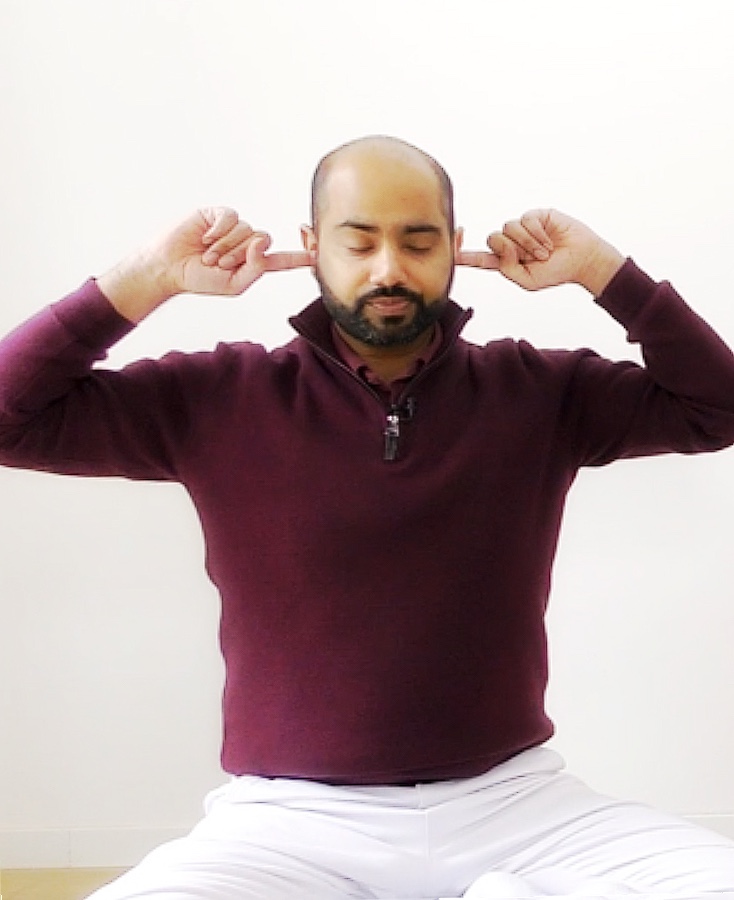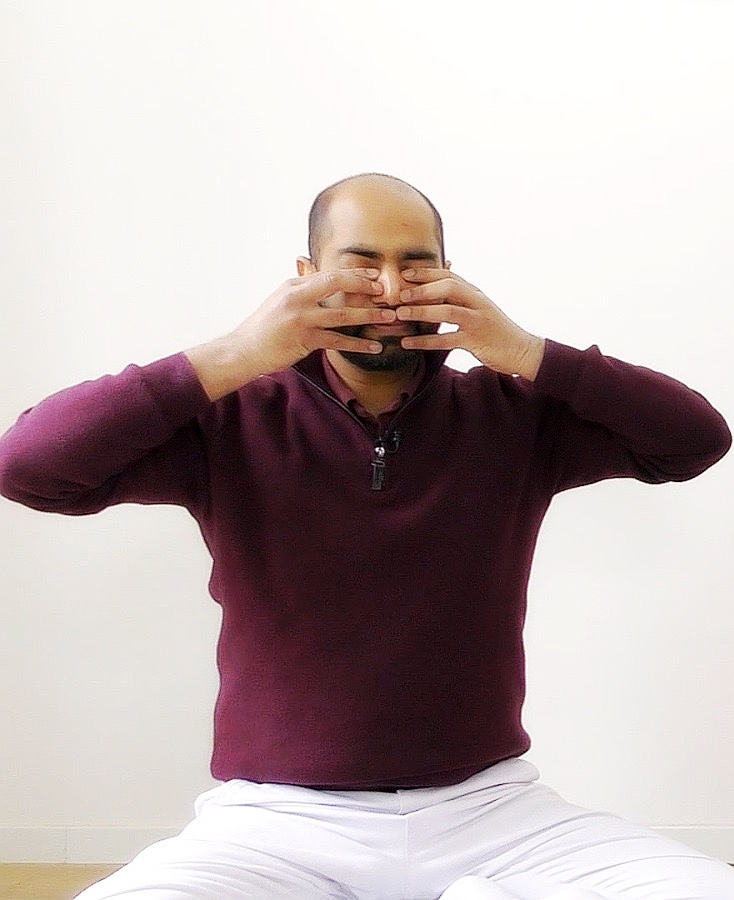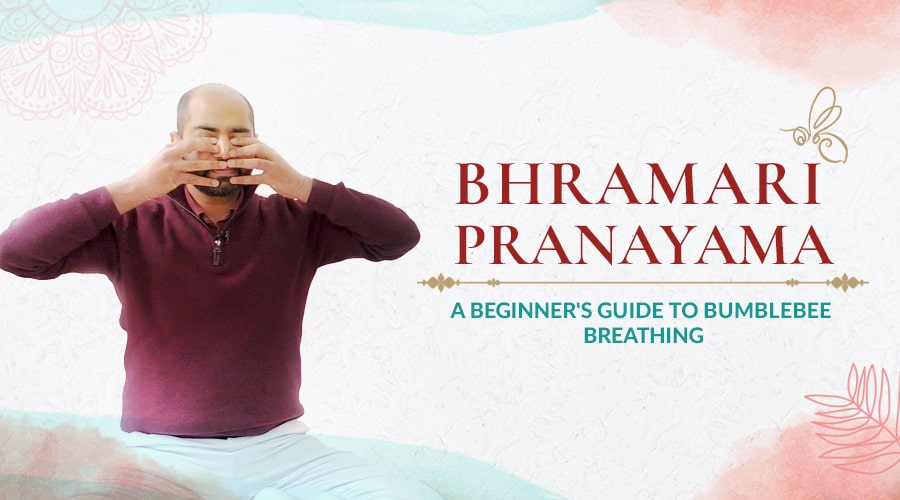In today's fast-paced and demanding world, stress and burnout are becoming increasingly common. With the constant pressure to perform and achieve, it can be easy to lose sight of our well-being and our ability to cope with the demands of everyday life. But there is a powerful tool that can help us combat these daily challenges, and it's called Bhramari Pranayama, or Bumblebee Breath.
Bhramari Pranayama is one of my favorite breathing exercises to calm down the mind and silent the senses. With its deep humming, it helps to withdraw from sensory overload and can also reduce headaches, improve focus and soothe symptoms of anxiety. And best of all, anyone can do it – even complete beginners!
If you’re struggling to slow down and find peace amongst the chaos, read on to discover the incredible benefits of Bhramari Pranayama and how to do it in a few simple steps.
What is Bhramari Pranayama?
Bhramari Pranayama is a calming breathing technique that has a soothing and healing effect on the mind. Also known as Bumblebee Breath and Humming Bee Breath, this pranayama exercise is named after the black bumblebee in India which has a deep buzz similar to the sound produced in Bhramari Breathing.
Bumblebee Breath involves sitting comfortably in a seated position with the eyes closed, and then making a humming sound while inhaling and exhaling through the nose. The sound of the humming creates a healing vibration that can help release tension and promote mental relaxation.
The goal of this pranayama practice is to help you regulate your breath and reduce the body's sensory inputs. This can bring balance to the nervous system and boost one’s mental and emotional well-being in miraculous ways.
What are the benefits of Bhramari Pranayama?
So, what’s all the buzz about? Over the years scientific research has shown that pranayama can positively impact the body and mind, with many long-term health benefits. Bumblebee Breath is not only easy to practice but is also a go-to stress-reliever and anxiety-soother in the yoga world and beyond.
The humming sound made during this practice has a powerful vibrational effect on the body, which can help to release tension, improve sleep, and even boost cardiovascular function. Here are some of the most significant Bhramari Pranayama benefits:
1. Calms the mind and reduces anxiety
One of the main benefits of Bhramari Pranayama is its ability to relax the mind and reduce feelings of anxiety. The steady and controlled breathing pattern, coupled with the humming sound, creates a sense of tranquility that can be deeply healing and calming.
2. Balances the nervous system
Bumblebee Breathing is believed to have a balancing effect on the nervous system. The humming sound created vibrates the muscles of the larynx and pharynx. This movement can stimulate the vagus nerve; a nerve that plays a key role in regulating the parasympathetic nervous system.
When the parasympathetic nervous system is activated, it stimulates our rest and digestion response which slows the heart rate, relaxes the muscles and promotes feelings of calm. Regular practice can therefore actively relax the body and mind.
3. Bolsters heart health
Bumblebee Breath is not only a great breathing technique for soothing the nervous system, but it can also greatly improve the health of your heart.
A recent study showed that Bhramari Pranayama was effective at overriding the sympathetic nervous system, promoting a deep relaxed state that could improve the resting cardiovascular parameters in healthy adults.
4. Sharpens focus and concentration
Another benefit of Bumblebee Breathing is its ability to improve concentration and focus. If you often struggle to drown out the mental chatter and outside distractions, this soothing breathing exercise creates a kind of mental force field that can help you slow down and clear your mind of negativity.
Additionally, the practice can help to improve mental clarity, leading to improved focus and cognitive function.
5. Lowers high blood pressure and reduces hypertension
Humming Bee Breath combines intense focus, controlled abdominal breathing and extended exhalations to calm a hyperactive sympathetic activity. In a single-arm study, this effect had the ability to lower high blood pressure and even improve symptoms of hypertension.
How to do Bhramari Pranayama: Beginner & Advanced
As highlighted above, Bumblebee Breath is a wonderfully soothing and healing breathing technique that can help you reach deeper states of relaxation and even find inner peace.
The key part of this pranayama exercise is the humming bee sound produced when your glottis, the space between your vocal cords, is actively constricted. For beginners, this might take some getting used to, but with regular practice, you’ll be humming just like the humble bumblebee.
Follow the steps below to experience the rejuvenating benefits of Bumblebee Breath. Once you’ve got the hang of it, you can move on to the more advanced variation of this technique with the Shanmukhi Mudra. This mudra reduces sensory stimulation, helping you reach a deeper level of relaxation.
Easy Bhramari Pranayama for Beginners
- In a comfortable seated position, close your ears with your index fingers.
- Place your index finger on the cartilage between your cheek and your ear. Your finger should not be inside your ear.
- Close your eyes and take a deep breath in through your nostrils. As you breathe in, slightly contract your glottis and gently engage your vocal cords to create a light snoring sound.
- Breathe in slowly and comfortably, and at the same time, create this snoring sound.
- Once you have completed your inhalation, breathe out for as long as you can.
- As you breathe out, create a high-pitched humming sound.
- Create this hum in your nose and visualize piercing your Third Eye Chakra (in between your eyebrows) with it.
- Repeat six to eight times and close with an extended exhalation.


Receive guided pranayama practices for more clarity & energy with master teacher Ram Jain for free
Bhramari Pranayama with Shanmukhi Mudra (Advanced)
- Close your eyes and focus on your natural breathing.
- Place your hands in Shanmukhi Mudra:
- Close your ears with your thumbs and place your index fingers on the lower parts of your eyelids to close your eyes.
- Use your middle fingers to partially close your nostrils.
- Then, place your ring fingers above your lips and your pinky fingers below your lips to close your mouth.
- Shanmukhi Mudra literally translates to “six mouths” and by placing our fingers into the above-mentioned positions we close the six mouths of our senses, lowering sensory input to a minimum.
- From here, breathe in through your nostrils and engage your vocal cords as if you are snoring.
- Once you have completed your inhalation, exhale for as long as you can.
- Create a high-pitched humming sound from your nose as you exhale, remembering to hold your Shanmukhi Mudra in place.
- Create this hum from your nose and visualize piercing your Third Eye Chakra with the sound.
- Repeat six to eight times and close with an exhalation.

How many times should you do Bhramari Pranayama?
Bhramari Pranayama is typically done for 2-5 minutes at a time. The number of repetitions can vary depending on the individual and their experience level, but if you’re a beginner, it is generally recommended to start with 6 repetitions and gradually increase the number over time.
Who should not practice Bhramari Pranayama?
Bhramari Pranayama is considered to be safe for most people to practice. That said, there are some contraindications you should keep in mind before attempting this technique. Some people who should avoid practicing Bumblebee Breathing include people with extremely high blood pressure and ear or sinus problems.
It's important to remember that people with any medical condition should always consult with their doctor before beginning any new exercise or breathing practices, especially if they have any doubts or concerns.
Final Thought
In a world where we are constantly bombarded with distractions and demands, we tend to lose touch with ourselves and what actually matters. Bumblebee Breath provides an opportunity to step back, slow down, and reconnect with our inner selves in a way that can be truly restorative and healing.
If you're looking for a way to combat stress and reconnect with your Self, Bhramari Pranayama is definitely worth considering. It's a simple yet powerful technique that can help you find a sense of inner peace and calm, no matter what's going on around you. Give it a try and see how it can benefit you.

